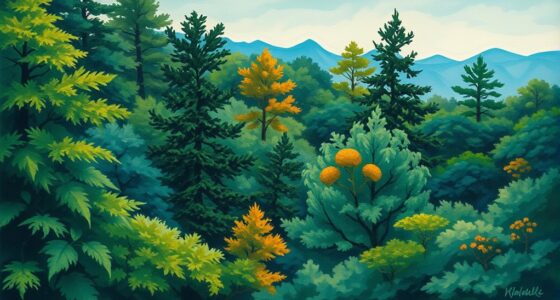Pointillism is a technique where you build images using tiny dots of color placed side by side. When you look at the artwork, your eyes blend these dots optically to create vibrant, luminous scenes. Artists carefully place each dot with precision, often using systematic methods. This approach relies on understanding how colors and optical illusions work together. If you explore further, you’ll discover how this meticulous process results in stunning, shimmering images that captivate the viewer.
Key Takeaways
- Pointillism uses tiny dots of pure color to create images through optical blending in the viewer’s eye.
- Artists systematically place dots, often using grids, to build detailed images layer by layer.
- The technique relies on understanding color relationships and visual perception for vibrant effects.
- Mastery involves precise placement and experimenting with dot size for different textures and tones.
- Significantly, pointillism combines artistic patience with scientific principles to produce luminous, cohesive images.

Pointillism is a mesmerizing painting technique that involves applying tiny dots of pure color to create a cohesive image. When you look at a pointillist masterpiece, you’ll notice how each dot contributes to the overall scene, blending seamlessly in your mind’s eye. This technique relies heavily on a specific techniques overview, where artists carefully place individual dots side by side, trusting that optical mixing will produce vibrant, luminous colors. Instead of blending pigments on a palette, they let your eyes do the work, creating a luminous, shimmering effect. Mastering this approach requires understanding visual perception to achieve the desired optical blending and vibrancy.
Pointillism uses tiny dots of color, blending optically for vibrant, shimmering images.
Famous artists played pivotal roles in popularizing pointillism, making this approach a significant chapter in art history. Georges Seurat is perhaps the most renowned figure associated with this technique. His masterpiece, *A Sunday on La Grande Jatte*, exemplifies how meticulous dot placement can evoke detailed scenes filled with life and depth. Seurat’s method involved a systematic approach, often using grids and careful planning to ensure the dots’ placement contributed to the overall harmony. Paul Signac is another prominent artist whose work pushed the boundaries of pointillism. He emphasized the importance of color theory, experimenting with complementary colors and varying dot sizes to achieve different textures and effects.
As you explore this technique, you’ll see that masterful use of the techniques overview requires patience and precision. Artists like Seurat and Signac didn’t rush their work; instead, they built images layer by layer, trusting the science of optics to blend the dots in viewers’ eyes. They often used a limited palette of colors, applying dots of pure hues that, when seen from a distance, produce a full spectrum of tones. This meticulous process creates a sense of vibrancy and movement, as if the image is alive and shimmering.
Understanding the techniques overview also means recognizing how these artists approached their canvases with a scientific mindset. They studied color relationships and optical illusions, which helped them develop a systematic way of constructing images. Their mastery of this method influences many contemporary artists interested in pointillism and related styles. When you observe a pointillist painting, you’re witnessing not just a scene captured in dots but a complex interplay of scientific understanding and artistic skill. It’s a testament to how patience and precision can transform tiny dots into a enthralling, cohesive visual experience.
Frequently Asked Questions
How Did Pointillism Originate Historically?
You can see that pointillism originated in the late 19th century, influenced by artistic movements like Impressionism and Neo-Impressionism. Artists like Georges Seurat developed it as a response to changing cultural contexts, emphasizing scientific approaches to color and light. This style aimed to create vibrant images through tiny dots, reflecting a shift towards experimentation and a desire to explore new artistic influences during that period.
Who Are the Most Famous Pointillist Artists?
Like Van Gogh’s bold brushstrokes, famous artists such as Georges Seurat and Paul Signac have left a lasting artistic influence through pointillism. You’ll recognize Seurat’s masterpiece “A Sunday on La Grande Jatte,” which exemplifies this technique’s meticulous dot application. These artists revolutionized color and form, inspiring generations with their innovative approach. Their work continues to influence modern art, proving that even tiny dots can build powerful, lasting images.
What Materials Are Best for Practicing Pointillism?
You should choose a smooth, primed canvas to make dot application easier. Use ideal brush types like round, fine-tipped brushes or even pointillism brushes designed for precise dots. Prepare your canvas with proper primer to guarantee the paint adheres well, and select high-quality acrylic or oil paints for vibrant, lasting color. These materials help you achieve the crisp, detailed dots that define successful pointillism artwork.
How Does Pointillism Differ From Other Impressionist Techniques?
Have you ever noticed how pointillism creates a unique visual texture with tiny dots? Unlike other impressionist techniques, it relies on placing individual dots of color side by side, which blend optically rather than physically. This technique comparison shows how pointillism emphasizes precision and detail, giving a vibrant, shimmering effect. Do you see how this method transforms a painting into a mosaic of colors that engage your eye differently?
Can Digital Tools Simulate Pointillist Art Effectively?
Yes, digital tools can effectively simulate pointillist art by mimicking digital brushwork and virtual color blending. You can create tiny dots with precise control, layering colors just like traditional pointillism. These tools allow you to experiment with virtual textures and gradients, giving you the flexibility to build detailed images with dots. While it may not fully replicate the tactile experience, digital platforms enable accurate and versatile pointillist-style artwork.
Conclusion
As you step back and see the tiny dots come together, you realize how patience transforms chaos into beauty. It’s a reminder that even the smallest efforts can create something extraordinary, much like a delicate pointillist masterpiece. In a world rushing forward, take a moment to appreciate the quiet power of detail. Sometimes, it’s the tiny, deliberate strokes that paint the most profound stories — a tribute to patience amid the chaos.









